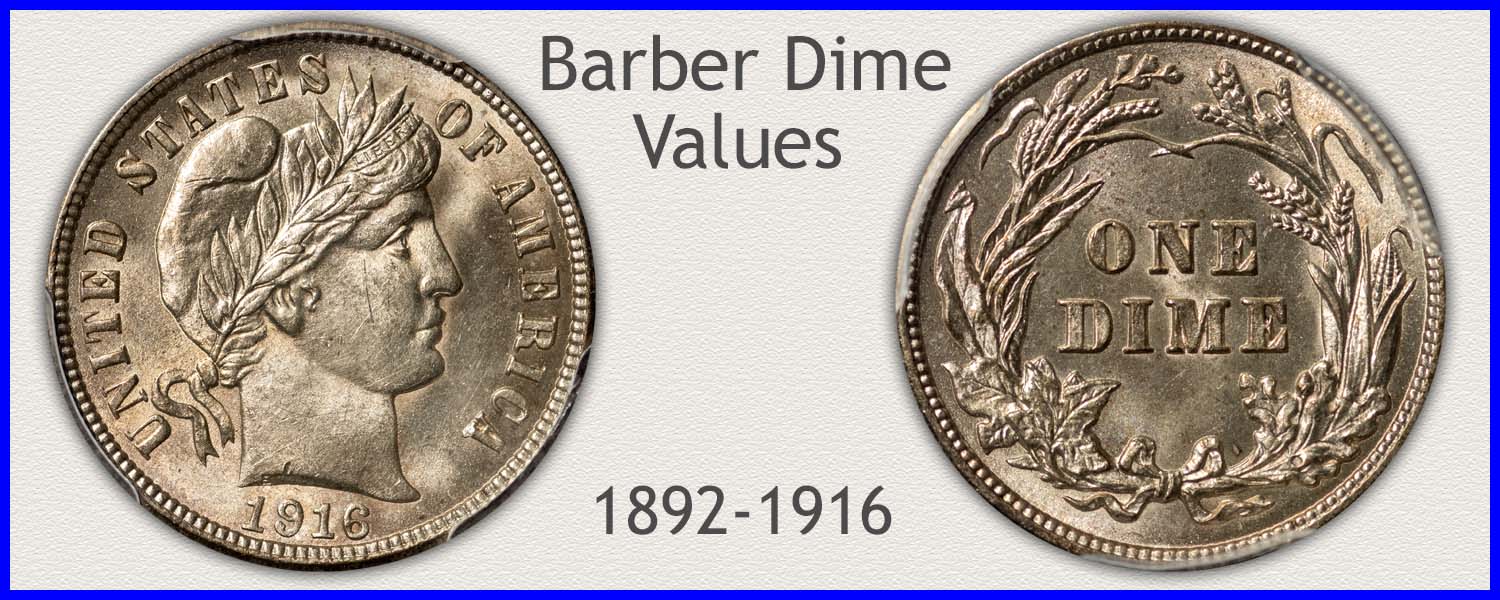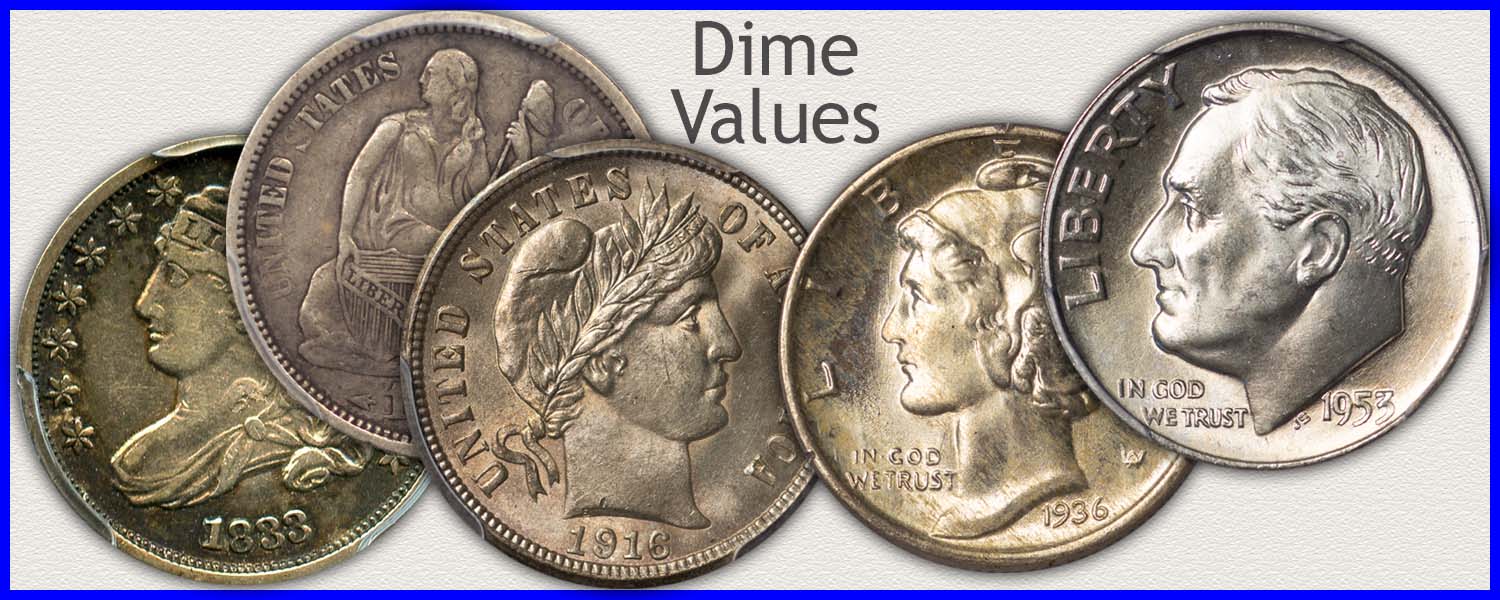Coin Values Moving with Precious Metals: Up-Dated 4/14/2025: Gold $3226 | Silver $31.88
1914 Dime Value
During your assessment, note the strong minimum 1914 dime value is the result of its silver content.
These Barber dimes were all minted with a 90% silver alloy. Silver is currently, 4/14/2025 trading in the $31.88 per ounce range. A nice start to how much these dimes are worth.
Proceed through the following steps, confirming the key factors helping identify any higher possible collector value. Of significance to collectors is the different mint issues of the year and the difficulty of finding coins in pleasing condition.
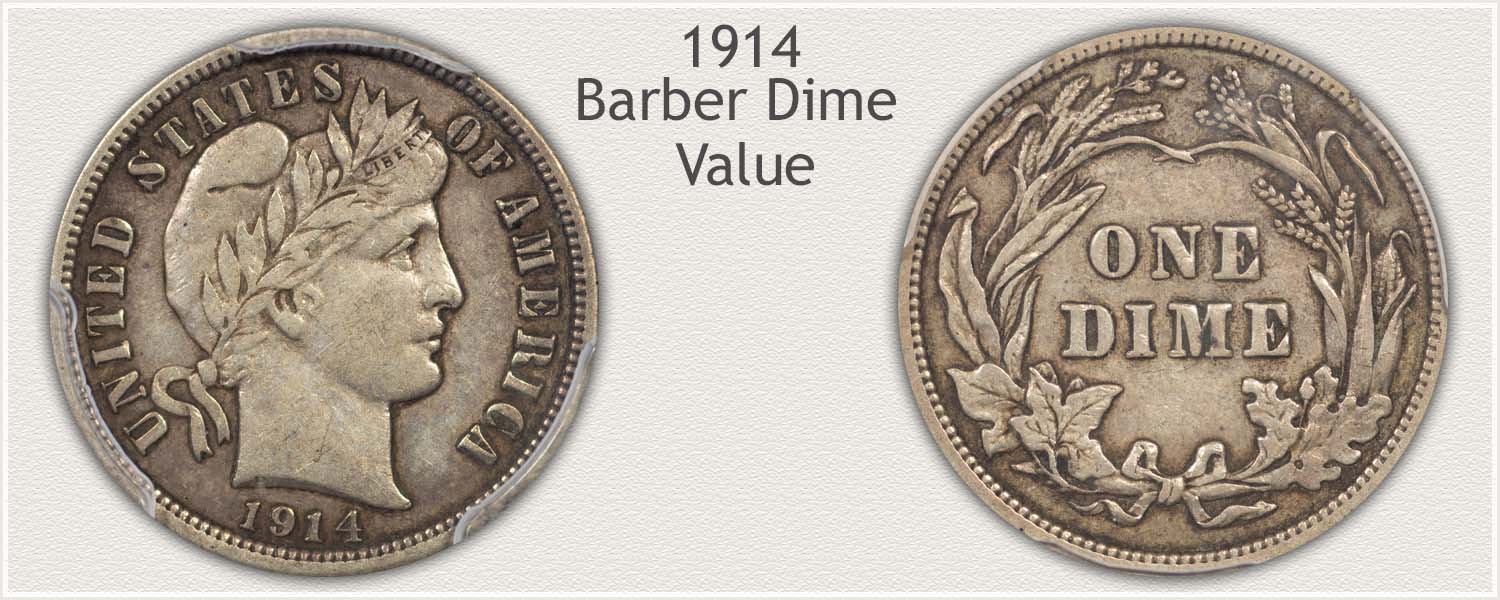
Steps Leading to Value:
- Step 1: Date and Mintmark Variety - An accurate description includes both the date and mint variety of these old dimes. 1914 dimes were made by three distinct mints.
- Step 2: Grading Condition - The condition of your Barber Dime is judged using descriptions. Collectors place a premium on coins that are visually pleasing.
- Step 3: Special Qualities - The next step is to judge the overall quality of these Barber dimes. Collectors prefer coins with no distracting blemishes or nicks.
| 1914 Dime Value | ||||
|---|---|---|---|---|
| Condition of Coin | ||||
| Date | Good | Fine | Extremely Fine | Mint State |
| Barber Dime Values Updated | 4/14/2025 | |||
| 1914 | $4.05 | $4.72 | $21 | $110 |
| 1914 D | $4.05 | $4.72 | $21 | $91 |
| 1914 S | $4.05 | $11.22 | $59 | $166 |
Values listed on chart are Wholesale indications. A database is maintained of auction results and dealer retail listings from which various mark-up factors are applied.
Step 1: | Confirm Date and Mintmark Variety
Three Varieties of 1914 Dimes to Recognize
Barber dimes were minted at three mints in ample quantities to supply commerce in 1914. Mintmarks were used to identified the branch mints, Denver and San Francisco. These are listed and valued separately on the above chart.
Creating demand for each variety are today's collectors building sets to include all 1914 mint issue dimes. Ever popular, San Francisco pieces are showing premiums when found in better than heavily worn condition. Inspect closely to confirm date and mint.
1914-S Barber Dime
"S" Mintmark on Reverse: San Francisco Mint Struck the Coin
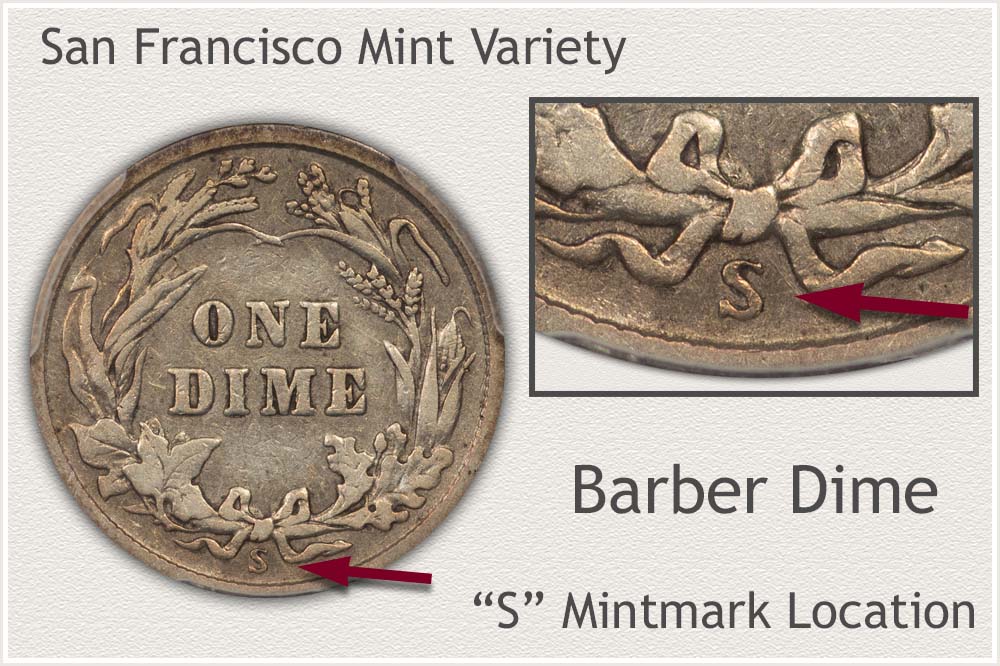
When the San Francisco dime was struck in 1914, it was made in sufficient quantities to fulfill the needs of the marketplace. More than 2 million coins were placed in circulation at the time. Today, very worn examples are abundant, and their value is impacted by fluctuations in silver prices.
Verifying the mint variety and next its condition helps to identify premium collectible quality and narrow the value. To identify their coinage, San Francisco placed an "S" mintmark on all Barber dimes. The "S" mark is located below the wreath on the reverse, indicating that it is a San Francisco variety.
1914-D Barber Dime
"D" Mintmark on Reverse: Denver Mint Struck the Coin
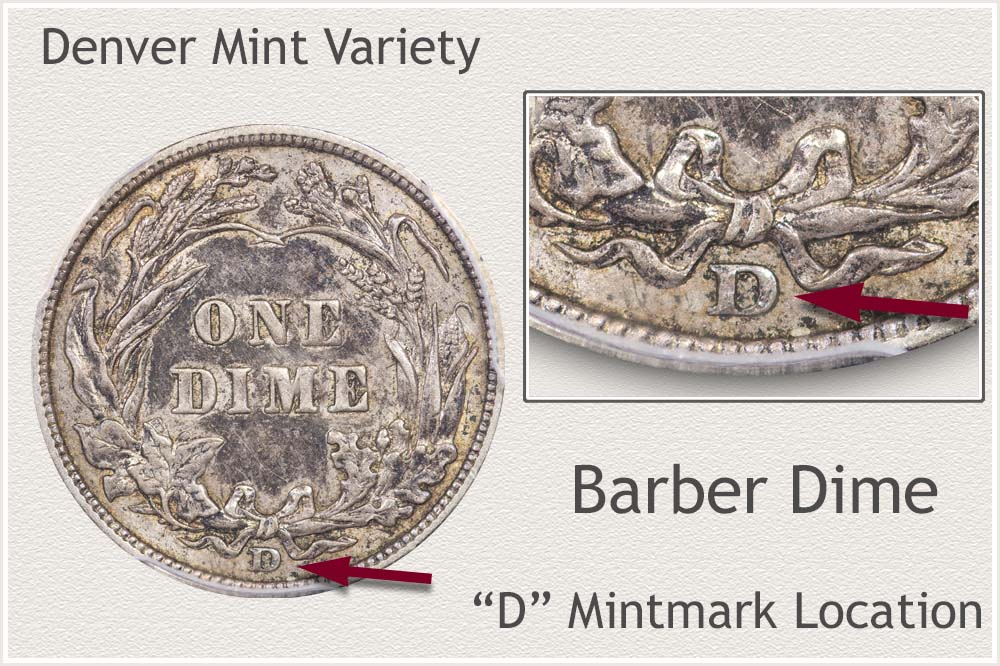
Representing the last Denver issue of the Barber series is the 1914 dime. Huge quantities were minted, totaling over 11.7 million entered circulation. Remaining in use for many years, most became very worn. These typical worn 1914 dimes are valued today based on silver content; all are 90% silver by weight. Finding higher, collectible quality requires judging their condition in Step:2 below.
With three mints striking dimes in 1914, branch mints used mintmarks to identify their coinage. Denver placed a large "D" along the lower rim. Looking just under the wreath and finding the "D" mark confirms the Denver variety Barber dime.
1914 Barber Dime
No Mintmark on Reverse: Philadelphia Mint Struck the Coin
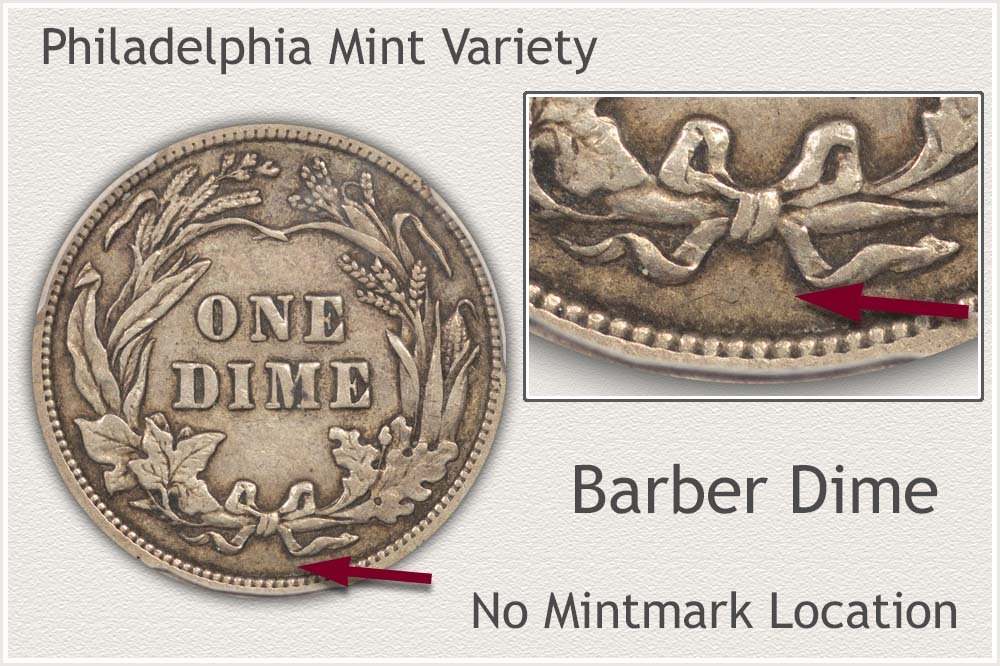
In 1914, the Philadelphia mint continued producing more than 17 million dimes annually. Today, there are plenty of these in existence to meet collectors' needs. Value of typical, heavily worn examples is close to the value of the silver they contain. Grading condition becomes necessary in Step 2 to judge the higher quality coin.
During the Barber series, Philadelphia did not use mintmarks on their coins. If you see a blank space between the ribbon ends of the bow on the reverse of the dime, it confirms Philadelphia minted the coin.
Step 2: | Judge Condition to Identify Grade and 1914 Dime Value
Determine Collector Quality by Small Details
Barber dime eye appeal is an important measure of value. A well-preserved coin is always in demand. Eye appeal and the coin's condition is "graded" compared to images representing different stages of wear. Grades define condition and are used to narrow a value range.
Below are images and descriptions of different grades helping find a close match to your coin. Ample detail within Liberty's hair is a collector quality dime worth above base silver value.
Mint State Grade
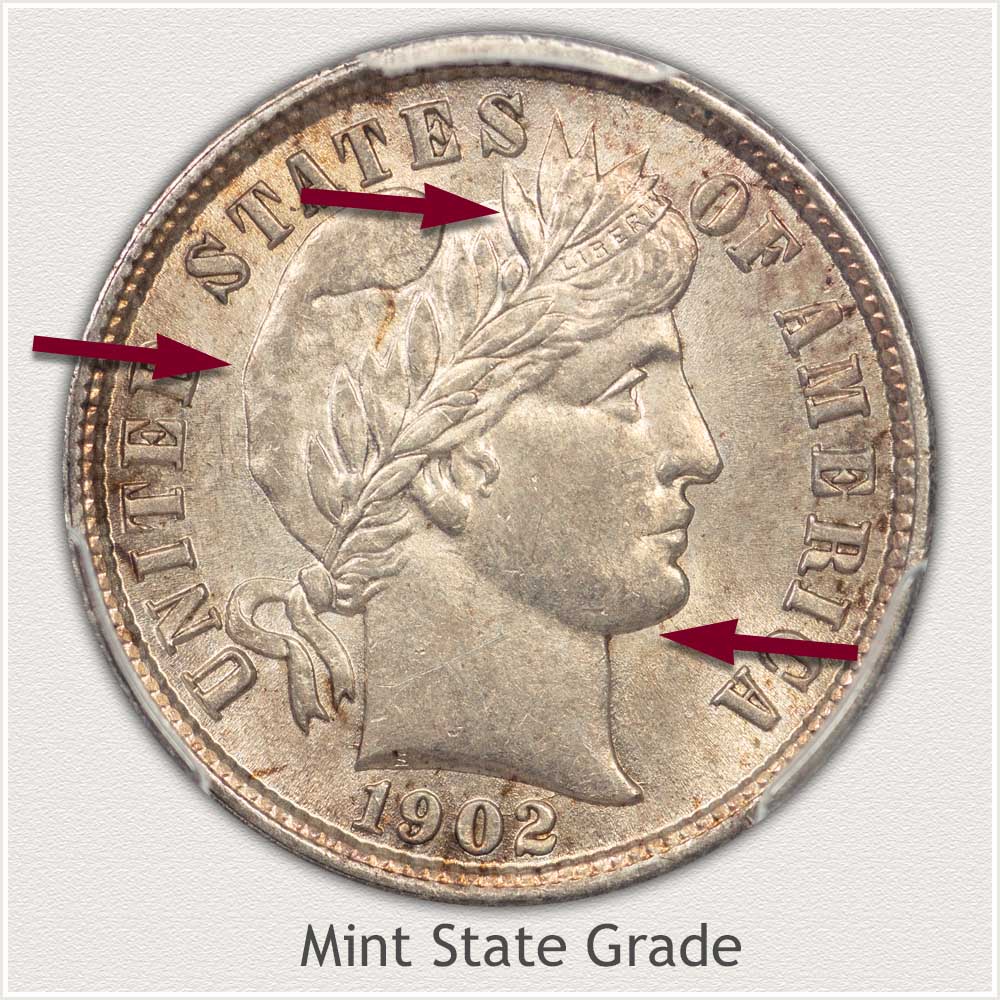
Mint State: Starting with a Mint State example helps when judging condition of Barber dimes. All original detail remains on these coins as minted. the portrait of Liberty is fully defined and no loss of detail on high points of design. The Mint State grade is defined by the absence of surface wear on a coin.
The absence of wear is determined by inspecting the design's highest points and flat unprotected areas. Both of these features are prone to metal removal. Liberty's jaw line, which extends from ear to chin, is located in the center of the coin and wears quickly. Luster, imparted during the minting process is delicate with a fine texture covering the jaw line. If circulated and worn the luster dulls and the metal becomes smooth.
Second, confirming that the example dime has no wear, the shine and original texture remains on the laurel leaves located above the headband near the "L" in Liberty. These two leaves also have high relief and flatten quickly if worn.
Barber dimes in mint state grade exhibit all of their original details and brilliance. When the coin is tilted under a single light source, luster radiates along its surface.
Extremely Fine Grade
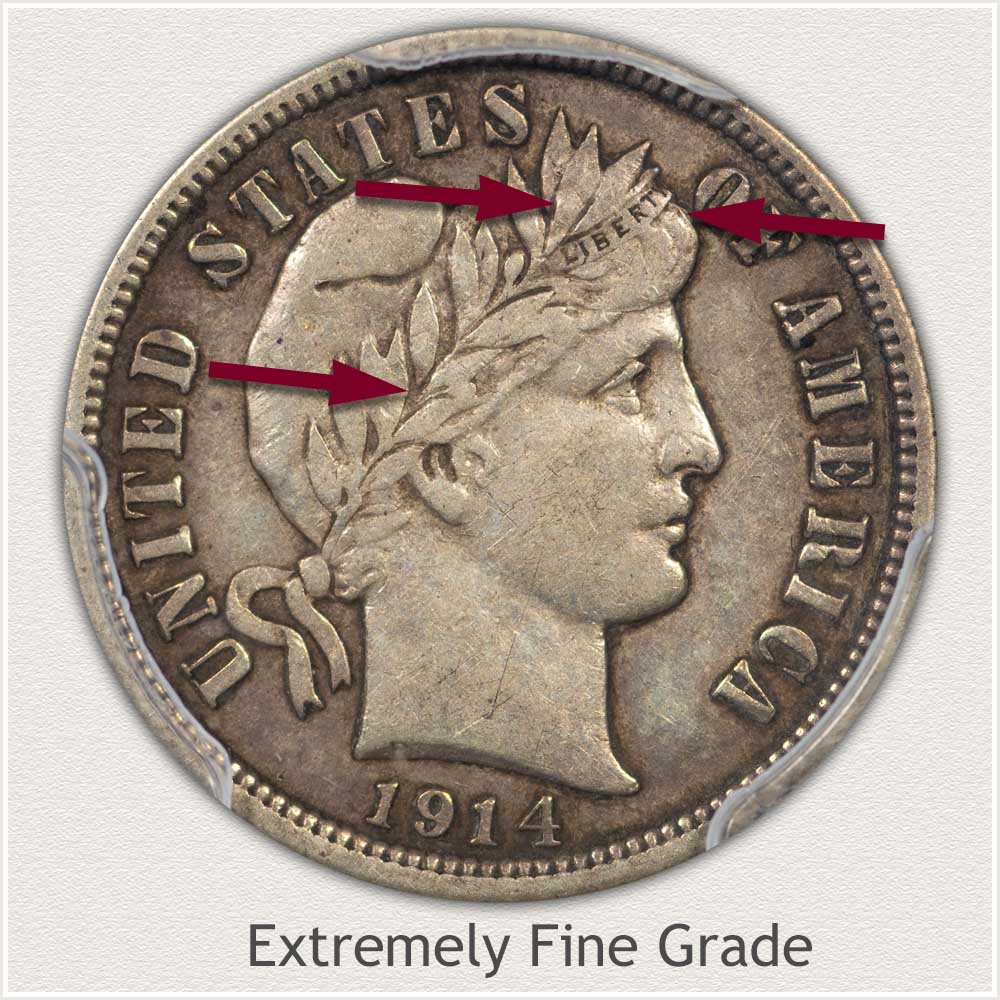
Extremely Fine: A premium Barber dime is one identified and judged to be in Extremely Fine condition. These collectible grades are defined by light wear just smoothing the highest areas of the design.
On the example, light wear is visible throughout the Laurel wreath of Liberty's portrait. Wear only flattens the edges and a small part of the centers of the upper row of leaves. However, the lower row of leaves is a bit more worn. Helping qualify for the grade, the lower leaves still retain their edges.
The headband on the portrait displays the lettering "Liberty" and is one of the highest relief areas on the dime. All letters are clearly readable, and the ribbon is distinct both along the top and bottom edges. These design elements clearly visible helps identify the Extremely Fine grade.
Fine Grade
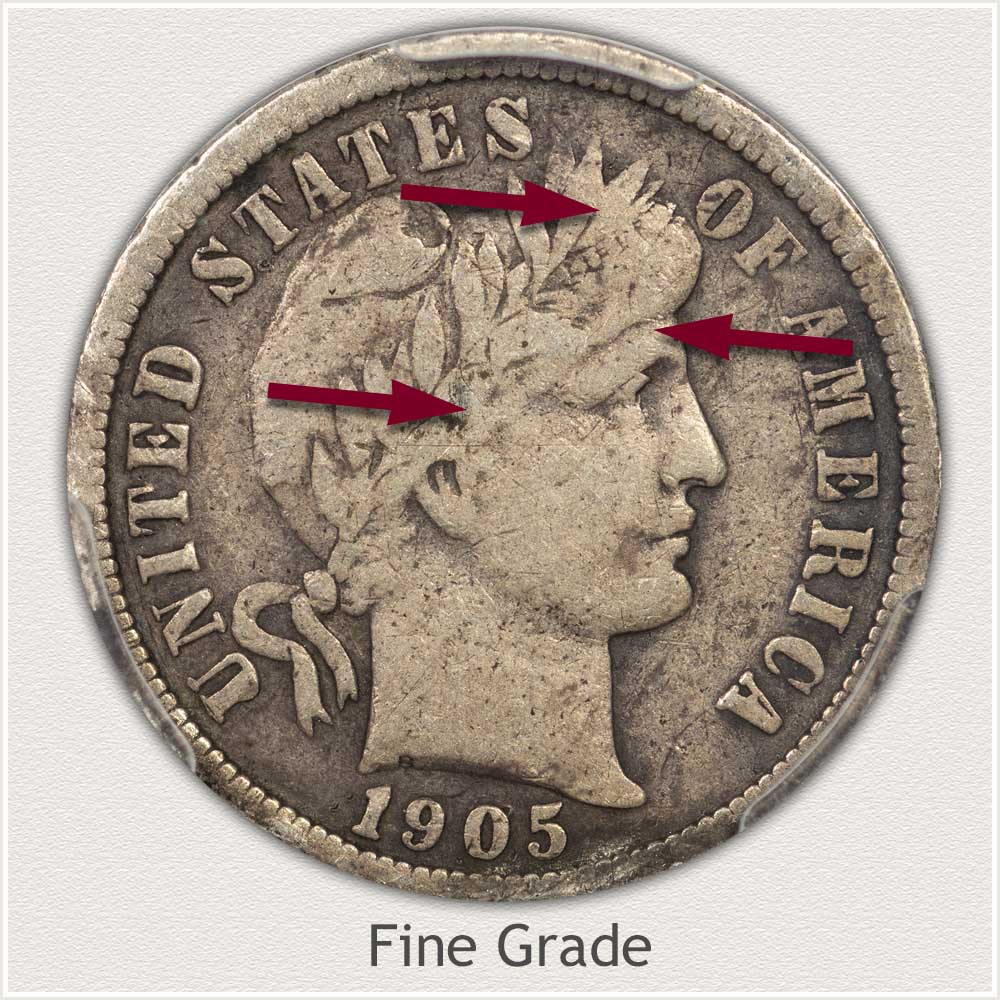
Fine Grade: A moderate amount of wear is visible on this Barber dime. Ample detail remaining helps distinguish the Fine grade. The wreath's leaves, letters on Liberty's headband, and the slight remaining contour on her face all help to confirm the condition.
It is possible to read "Liberty" in the headband of a somewhat worn, Fine-quality dime. When grading the Barber dime series, the condition of all visible letters is crucial to the grade.
Several large flattened areas are present on Liberty's face. However, the remaining contours on her cheek near her eye, a roundness in her neck, and indications of contours on her forehead all elevate the condition to Fine.
There's a subtle, but noticeable, line of hair visible just above her eye that adds detail to the portrait. An attractive and nice-looking dime with a lot of value to collectors.
Good Grade
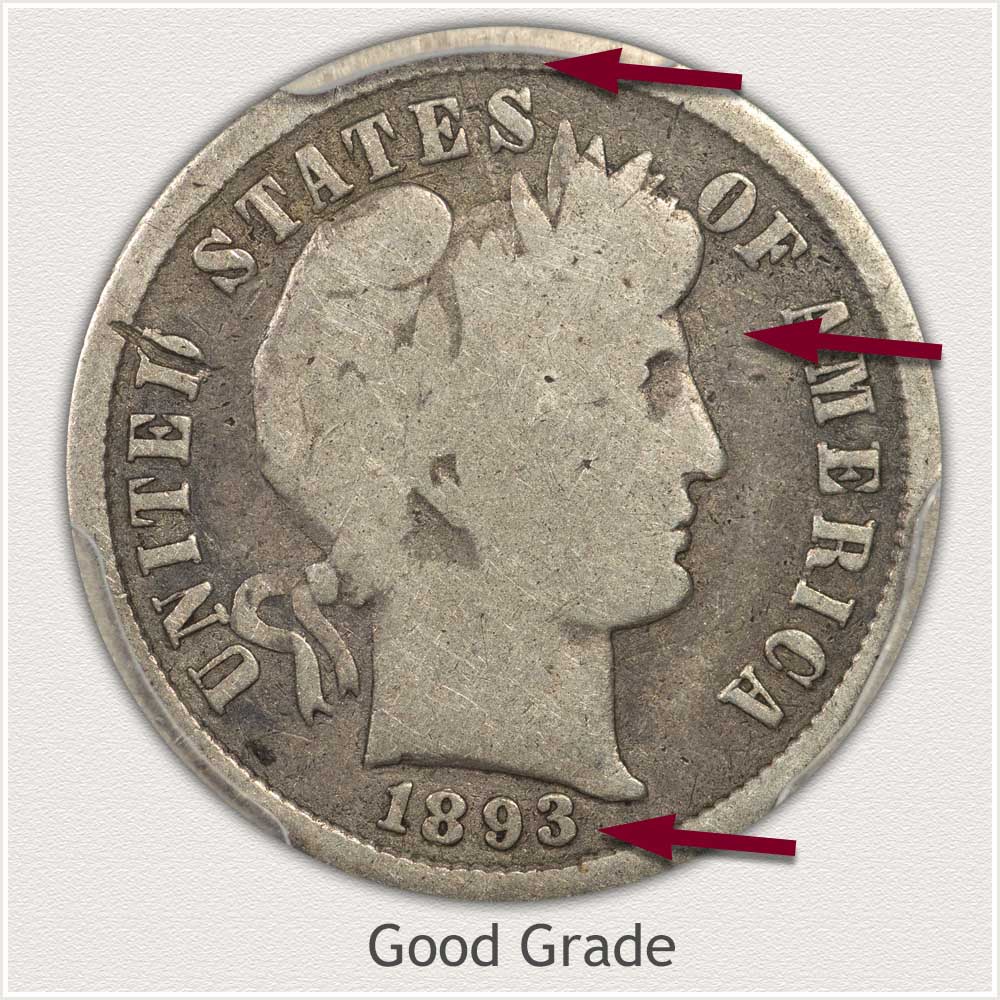
Good Grade: Good condition Barber dimes have noticeable, heavy, widespread wear. Defining a coin that has been greatly worn to the point that all fine detail has faded and the majority of main detail is now smooth. First impression of these coins is that they appear worn, although not worn out.
A flattened; featureless portrait of Liberty earns the example a good grade. Her face and hair have mostly lost their finer qualities. The fact that the portrait is bold from the field is an added bonus.
A key factor recognizing a strong grade is the letters along the rim are complete and the date is very clear. An additional element of appeal is the entire non faded rim. A good example for the grade, with even wear and major details still present.
How to Video: Grading Barber Dimes
Grading examples are expanded in order to confirm a narrow grade. When placing a value on these Barber dimes, condition is very important.
Video, Images and Descriptions | Grading Barber Dimes
Step 3: | Special Qualities | Found in Subtle Details
1914 Barber dimes are one of the years in the series known for its availability. Many examples of the 1914 dime remain from the millions struck at each mint. Most are of low condition lacking appeal to collectors. However, some display recognizable special qualities. With a close look, collector quality and premium value is identified by subtle details found.
Abundant are coins in heavily worn condition. These lower condition examples trade based on their silver value, moving up and down with the price of silver. Collector quality is noted as having a detailed design remaining and stable values far higher than intrinsic silver worth.
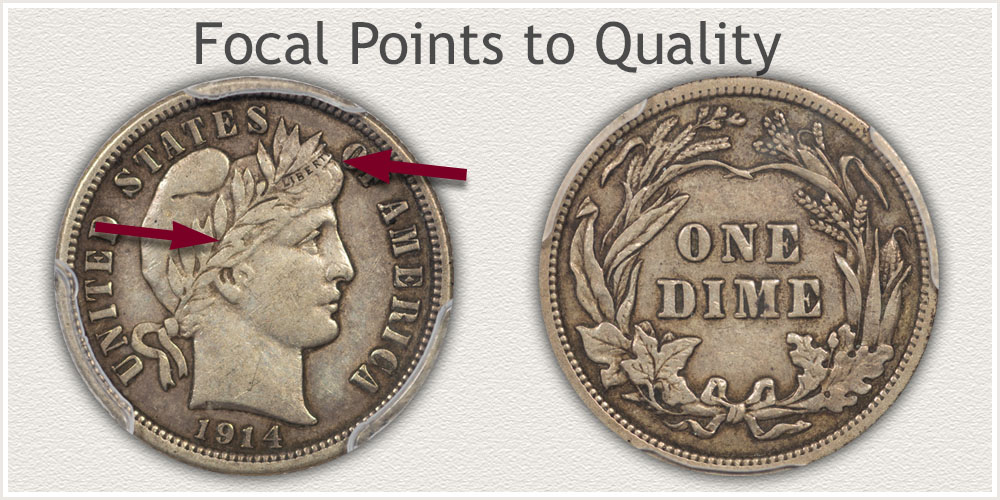
Two visible traits quickly identify the special quality dime from base silver value pieces.
Higher quality is noted by the amount of detail the design displays. With a focus on Liberty and specifically her head band, recognizing a few details points to high quality.
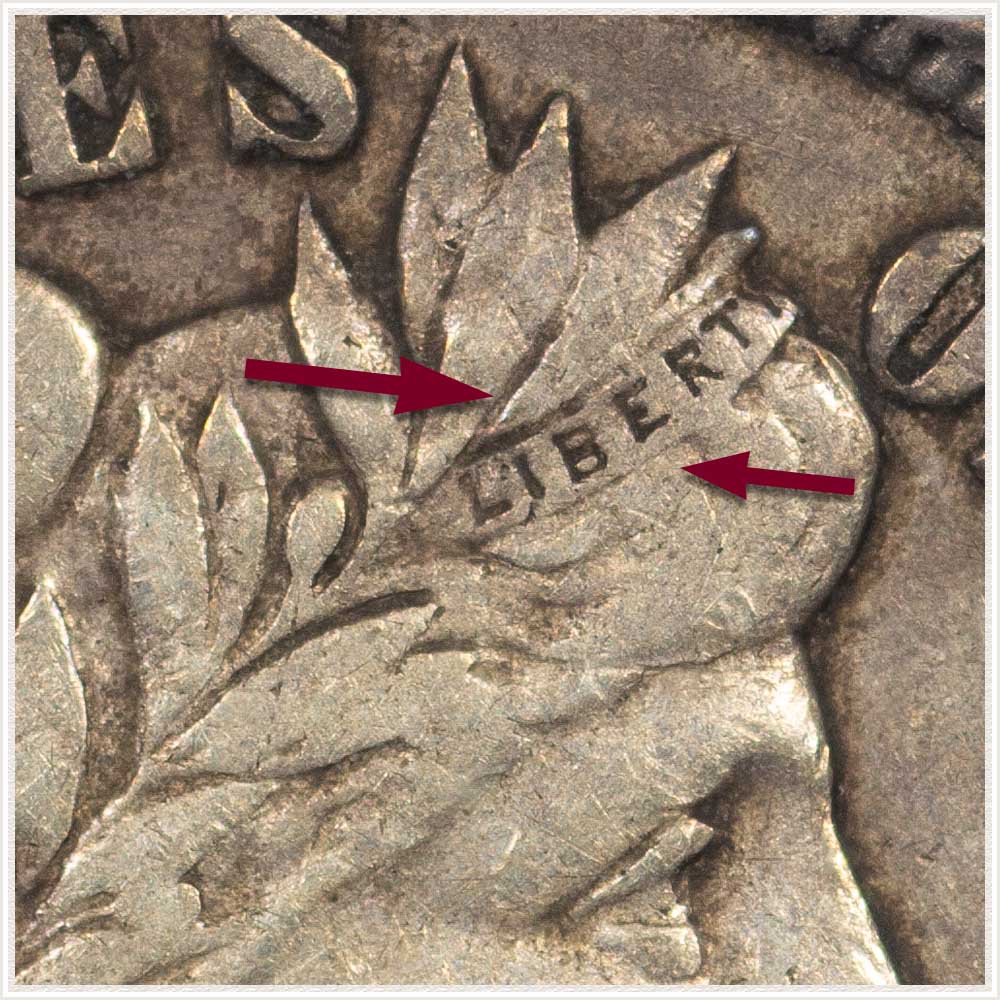
Note all letters of "Liberty" within the head band are visible. Of importance is the fine line representing the lower edge to the band is visible and distinct. A clear indication of a high-quality Barber dime. This is indicating the Extremely Fine grade, and added value.
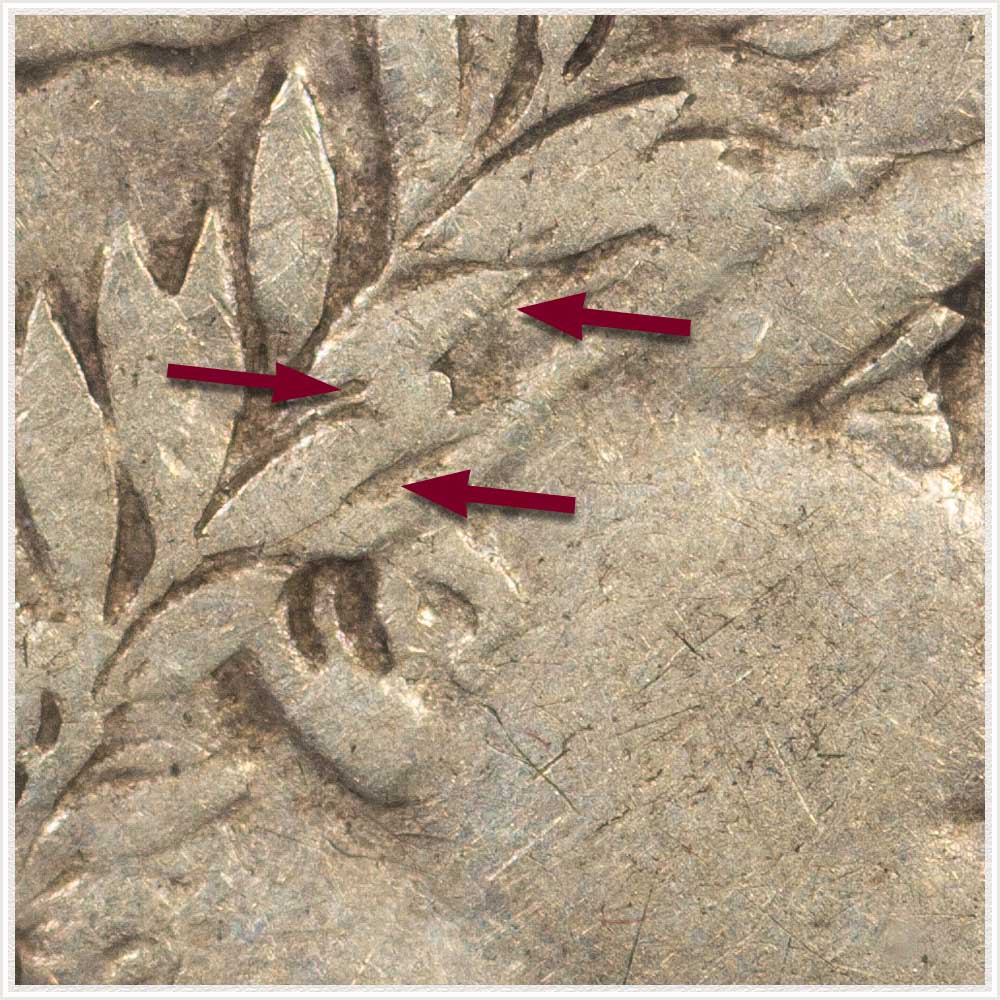
This second area of interest is the Leaf - Berry - Leaf design just above Liberty's ear. Collector quality coins display the area with enough detail to decern the three elements of leaves and berry. Laurel leaves are a tapered shape ending at a point. Stating at the ear and following upward is a small line of hair detail then above is the first leaf, remaining clear. Just above with a slight raised profile is the berry, note the stem. Finished with the clear leaf above the berry. All of these features are slightly raised and distinct.
On lesser quality coins the fine elements described, ribbon edge, and leaf-berry detail is blended and missing. A 5x-power magnifying glass is used to confirm these subtle and important qualities. When found, a solid Extremely Fine grade is indicated.
References
U.S. Mint. 1891 U.S. Mint Annual Report
https://nnp.wustl.edu/library/book/512060
U.S. Mint. Catalogue of Coins of the United States
https://nnp.wustl.edu/library/book/554591
U.S. Mint. 1915 U.S. Mint Annual Report
https://nnp.wustl.edu/library/book/514128
Coin Values | CoinStudy Articles
Date by Date
In Depth Barber Dime Values
1892 to 1916
Barber Dime Value | Identify Their Potential Worth
Barber dimes have now become an older series with many date and mint combinations worth well above base silver value. Each is $4.05 because of their 90% silver alloy. Many have low mintage numbers, are scarce and collected in all conditions with strong premiums.
All Dime Series are featured here. First minted in 1796 there are many rare and collectible varieties to discover.
From the early Bust to the Seated Liberty of 1837-1891. Next the Barber Dime followed by the widely collected Mercury Head dime. Ending with the modern Roosevelt Dimes. Match your coins to the grading images and values charts.
Quickly sort through your old coins and identify the series. Each domination of U.S. coins is represented by images of the specific series and dates. Follow links to value charts and the process to determine how much they are worth.
Silver Coin Values | Minimum Values of U.S. Silver Coins
Following the up and down movements in silver price many, U.S. coins are accurately valued daily. Using the calculator, determine values of silver dimes, quarters, halves, and silver dollars.
Rare Dimes | Early Silver Issues
Spotting a rare dime is often just recognizing the early silver alloy types. A strong base to value, silver as part of coinage was discontinued in 1964. These older dimes are becoming scarce and worth well above ten cents. Early dimes prior to 1900 are all scarce and collectible. Rare dimes of U.S. coinage are featured.
★Coin Values Discovery finds 1914 Dime Value and...
Barber dimes are one of many series of with premium coin values. Identify your coin and variety, follow a step by step method used by collectors and discover how much old coins are worth.
